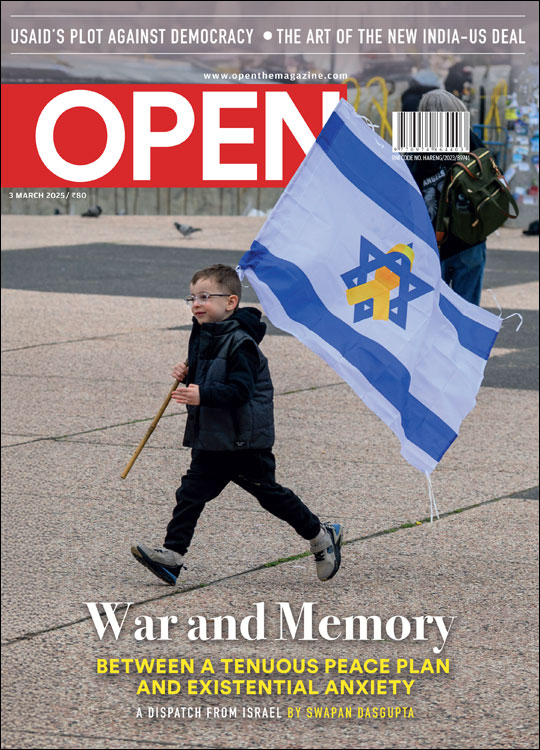Guru M
The fastest growing yogi of India doubles as a modern-day Kabir to spread the gospel of peace. We meet Sri M who was once Mumtaz Ali Khan
/wp-content/uploads/2015/11/GuruM-main.jpg)
The fastest growing yogi of India doubles as a modern-day Kabir to spread the gospel of peace. We meet Sri M who was once Mumtaz Ali Khan
Renowned Malwi folk singer Prahlad Tipanya, who has made Kabir’s devotional songs such as Tu Ka Tu and Tara Rang Mahal Mein extremely popular overseas, was looking forward to meet the person he thought internalised the teachings of the 15th century saint-poet like no one else has done. “I also admire guruji Sri M for his simplicity and his innocent smile,” he says in chaste Hindi as we drive down from Bangalore to Madanapalle. Tipanya had met Sri M before, but not in Madanapalle, which is in Andhra Pradesh, where the 66-year-old yogi lives. A few hours later, the singer touches the feet of the guru who had initiated him into kriya yoga, which is at the heart of Sri M’s training as a member of the Nath tradition, just as it was Kabir’s. “The last time we met, you threw instructions in English and it was fun to hear it because I didn’t understand one bit,” Tipanya tells Sri M, who erupts in childlike laughter.
Kriya yoga, the ancient form of yoga believed to have been revived by Mahavatar Babaji, guru of Sri M’s master Maheshwar Babaji, has brought many people from across the world to Madanapalle. Besides Tipanya and others, the visitors outside Sri M’s home Snow White—he named it so because of his fascination for snow-clad mountains— include Lina from Lithuania. For someone from a country that boasts of ultra high-speed internet connections, it’s ironic that she knew about the guru through word-of-mouth originating in yoga academies within India and elsewhere. “I wanted to come here for a long time since hearing about him. I had to postpone my trip many times. I am glad that I am learning the right things. Until I came here, I had a very different idea of what yoga was,” she says. Yoga has connected Sri M with many other followers too, including the likes of actor Rajinikanth.
“I look up to Sri M, and I consult him on spiritual matters. I am closely involved with him in my spiritual practice. I also take a lot of tips from him on kriya yoga so that I don’t pick up any mistakes,” says Rajinikath, who emphasises the importance of gurus taking up initiatives to foster peace in the country. “One such is Sri M’s plans to embark on a journey by foot from Kanyakumari to Srinagar,” he adds.
Walk for Peace
Sri M, who was born Mumtaz Ali Khan in 1948 in Thiruvananthapuram to fourth- generation migrants from the North West Frontier Province, vows to spread the message of communal amity by organising multi-faith prayer meetings, planting trees, cleaning public places and teaching people meditation techniques as part of his ‘walk of hope’. He plans to walk more than 6,000 km over one-and-a-half years, starting early 2015. “We won’t walk too long in one day. We would end up covering 18-20 km a day and would retire at the end of a day in either a temple or a church or a mosque or a gurdwara or any place that offers us shelter at night,” says Sri M, who will be accompanied by a core team of 35-40 members. While he expects thousands of others to join him, he often tells his disciples excited about the walk that “it is not a rathyatra but a padyatra”.
Muslim by birth and Hindu by initiation, Sri M—who left home aged 19 to live and wander the Himalayas in pursuit of spiritual knowledge—sounds self-effacing at the mention of his venturing into the karma mode or pursuing the path of social reforms. There is also a frequent comparison he squirms at: that with Kabir, who is revered in India by Hindus and Muslims alike. He admits some similarities. “Kabir, of course, was like me in some ways: he was born into a Muslim family (a family of weavers in Varanasi); like me, he was also inspired by Hindu philosophy. He called the Supreme Being ‘Ram’ not ‘Lord Ram’, but ‘Shuddha Brahma Paratpara Ram’,” says Sri M, who came under the spell of Kabir’s philosophy as a child. According to Kabir scholar Linda Hess, after learning the family craft of weaving, Kabir is believed to have “studied meditative and devotional practices with a Hindu guru and developed into a powerful teacher and poet, unique in his autonomy, intensity and abrasiveness”.
Sri M, meanwhile, notes that he would really want to help with the work that Kabir, an iconoclast, left incomplete, especially in bridging communities and helping them live in peace. He feels that communal strife, which seems to have gripped parts of India, is not always because of religion. “It happens when some people exploit religion for their vested interests. More and more people should be made aware of these power struggles, politics and so on,” he says.
What M stands for
The guru’s ‘M’ is not merely short for ‘Mumtaz’. Sri M’s name in the Nath tradition starts with M, Madhukarnath. As a painter, the guru, who is also the author of the book, Apprenticed to a Himalayan Master, among others, used to sign off as ‘MM Ali’ or ‘M Ali’ on his works of art, a few of which still hang in his home. It was a friend from the Jaisalmer royal family who first called him ‘M’. Then she decided M was not reverential enough. She started calling him ‘Mr M’, but some people objected, saying it reminded them of James Bond’s boss M from Ian Fleming’s series. Finally, the friend’s niece suggested ‘Sri M’, and it stuck.
Soon, he decided to write the story of his life: his meeting with his master who appeared before him when he was just nine; his journey in which he discovered that he was reborn as Mumtaz Ali—and that he knew his master and the practice of yoga from his previous birth; his series of mystical experiences, initiation into the Hindu order, encounter with the Yeti and several other ‘hard to believe’ stories.
It was in 2011 that he published Apprenticed to a Himalayan Master, and he did so after much thought. He says he had waited for 25 years in fear that people would distrust him. But he was committed to his guru’s wish: that he write an autobiography. ‘Until now I have held most of the experiences written in this book close to my heart, never giving more than a hint even to my closest friends. However, I felt that I had no right to deny what I had experienced to people, so after deliberating a great deal, I reluctantly began to write this book,’ Sri M wrote in the foreword to the book, which has sold over 400,000 copies since and been translated into many languages (it has a Braille version too). For sceptics, this writer included, who tell Sri M that his book could be dismissed by some as a collection of cock-and-bull stories that have no scientific foundation, he has an answer ready. “There is this book called Proof of Heaven written by neurologist Eben Alexander MD, in which the author, once deeply distrustful of mystical experiences, writes of his own near-death experience,” says Sri M, who has also authored books on the Upanishads and on Hindu thought.
Seeker’s Quest
Readers of Apprenticed to a Himalayan Master know only too well the mystical experiences Sri M has had as a child. Besides meeting his own guru Maheshwar Babaji, a tall and fair 30-year -old-looking man with very little facial hair, as a nine-year-old, he was also destined to experience bliss and epiphanic moments when he met many holy men in and around his home town of Thiruvananthapuram and elsewhere, starting from the naked Sufi, Kaladi Masthan; Gopala Saami; Mai Amma and others. He was also destined to meet Neem Karoli Baba and the head of his own order, Sri Guru Babaji, who is also referred to as Mahavatar Babaji in Paramahansa Yogananda’s book Autobiography of a Yogi.
Before Sri M left home when he was 19 for the Himalayas, he had done what he calls “trial runs” to Kanyakumari and Tirunelveli and other nearby places, where he often stayed in various ashrams. When he finally left for the Himalayas, he was flush with funds to pay for his train tickets. He travelled by rail from Thiruvananthapuram to Egmore in Tamil Nadu, where he stayed on the Theosophical Society of India campus; a few days later, he boarded the GT Express to Delhi, took another train to Hardwar, where he halted for several days before leaving for Rishikesh. It was then he realised that the snow-clad mountains that he was always longing to see couldn’t be seen in Rishikesh. After staying for a few days in Vasishta Cave there, he began to walk and hitchhike occasionally. He reached Badrinath a month later. He was offered shelter across the Alaknanda river by Ravalji, the head priest of the Badrinath Temple. Within a few days, he began to feel depressed because he had expected spiritual bliss on reaching these destinations. “I was contemplating jumping into the river,” he says, “It was then I passed by Vyasa Cave and saw it was empty. Then I happened to return a while later. I saw someone was inside. So I decided to explore. There I met a man whose eyes were the same as those of the man I met when I was just nine. ‘I will stay with you forever,’ I told him.”
That was Maheshwar Babaji, the saint who never wore anything other than a towel around his waist even at the height of winter, who went on to train Sri M in the Upanishads and kriya yoga and meditation for the next three years. “My typical day in the Himalayas started around 5.30 am. I used to go collect some firewood, then wash my face and sit for meditation. Then we used to have an hour of yoga. Cooking was over in an hour. I had been trained by Babaji. Till evening I had time to wander around and explore. The evening meditation used to be longish,” recalls Sri M. It was under Babaji’s guidance that he learnt to wander the Himalayas, and took a tortuous journey to Tholingmutt in Tibet on a failed mission to Kailash.
Sri M says he had got used to life in the Himalayas when his guru dropped the bomb shell: you have to work with the masses. This can’t go on forever.
He didn’t want to return to “the plains” and work, but finally bowed to his guru’s demand. Sri M also ended up working closely with people Babaji had asked him to meet, including J Krishnamurti, in his last years. Sri M worked briefly as a journalist, including as a trainee at India Today, and with New Wave, Andaman Times, Manthan and so on. He also returned home and helped the family with its medical distribution business.
Forefathers
Sri M’s ancestors were brought to India in the early 18th century by the Maharaja of Travancore, Marthanda Varma, who distrusted his soldiers and had powerful enemies such as Ettuveettil Pillas. Until recently, a member of Sri M’s family used to accompany the maharaja in his customary procession at the Aarat festival at the Sree Padmanabhaswamy Temple in Thiruvananthapuram.
By the time Sri M was born, the family had lost touch with its mother tongue, Pashtu, but never spoke in Malayalam. “We always spoke a variant of Urdu at home which can be called as Deccani- Urdu. This helped in communicating with my master. It also helped that I went to a good English-medium school in Thiruvananthapuram,” says Sri M.
In a family that was reluctant to have any member marry even Kerala Muslims, it was Sri M who broke all traditions by marrying a Saraswat Brahmin, Sunanda, with whom he has two children.
Sri M, founder of the Satsang Foundation, is a breakaway from the usual mould of gurus in an instantly apparent way as well: he is clean-shaven.
He doesn’t talk in monosyllables. He wears a shirt and trousers or dhoti. He doesn’t perform any miracles; in fact, he has written a book titled How to Levitate under a nom de plume, James Talbot, explaining various tricks employed by godmen to lure crowds. “I performed the levitation trick before Krishnamurti and then showed him how I did it. He was amazed,” says Sri M.
Sri M, who has worked in institutions run by Krishnamurti and as the philosopher- guru’s confidant as well, remembers him as a down-to-earth person. “He had great humility. One day he was taking a walk and a wheelchair-bound boy was being wheeled around him. When he asked someone why he was being wheeled around, he was told that they believed he had the healing powers to cure the boy. He was shocked; ‘Are you pulling my leg? Please tell them I can’t do a thing like that,’ he said.”
Sri M seems to have taken a leaf or two out of Krishnamurti’s book. He says that for days before he delivers a talk on the Upanishads, he reads his favourite PG Wodehouse novel or Sherlock Holmes or comic books such as Asterix and Tintin. “I always want my mind to be a clean slate before such occasions,” he says. He also goes for holidays, especially to get away from the madding crowd. He “flees” to Writer’s Bungalow in Ramgarh in Kumaon Hills, or to a hideout his family owns in Bandipur, or to a property on an island near Payyannoor in Kerala that can be accessed only by boat.
But now it is time for some karma, declares Sri M, who often falls back on Swami Vivekananda’s Complete Works for inspiration. It is time to walk the talk.

/wp-content/uploads/2025/02/Israel.jpg)













More Columns
Passion for the Preloved Saumyaa Vohra
Mum’s the Word Kaveree Bamzai
Losers Back Home, On Top in Thailand Kaveree Bamzai